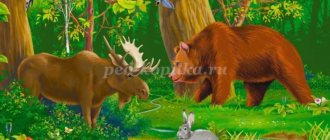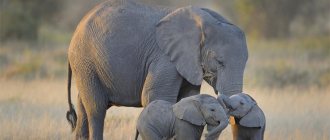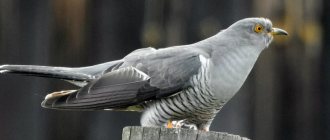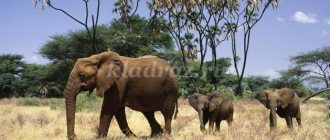Herbivores
Lemming
Outwardly, it is little different from a hamster; it also belongs to rodents. The animal weighs about 80 grams and reaches 15 centimeters in length. The lemming's fur is brown. There are subspecies that turn white in winter. In cold weather the animal remains active.
Lemmings are Arctic animals that feed on plant shoots, seeds, moss, and berries. Most of all, northern “hamsters” love young shoots.
Herbivorous lemmings themselves provide food for many Arctic inhabitants
Muskox
It lives mainly in northern Greenland and the Taimyr Peninsula. The number of the species is declining, so in 1996 the musk ox was listed in the Red Book. The closest relatives of the northern giants are mountain sheep. Outwardly, musk oxen are more similar to bovid animals.
The approximate height of the musk ox is 140 centimeters. The animals listed in the Arctic Red Book reach 2.5 meters in length There is only one species living on the planet. There used to be two, but one has died out.
These giant bulls are on the verge of extinction and are protected by law
Belyak
Recently isolated as a separate species, it no longer belongs to the common hare. The Arctic hare has short ears. This reduces heat loss. Thick, fluffy fur also saves from the cold. The body weight of the Arctic hare is greater than that of the common hare. The length of the resident of the North reaches 70 centimeters.
In the photo, Arctic animals often eat woody parts of plants. This is the basis of the hare's diet. However, favorite dishes are buds, berries, and young grass.
You can distinguish an Arctic hare from a regular hare by their shorter ears.
Reindeer
Unlike other deer, they have changeable hooves. In summer, their base resembles a sponge, cushioning on soft ground. In winter, the pores tighten, and the dense and pointed edges of the hooves become pronounced. They crash into ice and snow, eliminating slipping.
There are 45 species of deer on the planet, and only the northern one grows antlers, regardless of whether it is a male or a female. Moreover, males shed their hats by the beginning of winter. It turns out that Santa's sleigh is pulled by reindeer.
Both male and female reindeer have antlers
Lemming
This small northern animal is very similar to a hamster both in appearance and in its lifestyle. The rodent feeds on sedge, mosses and tundra shrubs. Lemmings reproduce quickly: the female gives birth to 4-5 litters of up to 12 babies per year. It is also believed that lemmings can commit mass suicide by jumping off cliffs. And it’s true that the number of lemmings sometimes decreases noticeably.
Lemming
Predators
Arctic fox
Otherwise called the polar fox, it belongs to the canine family. As for domestic animals, it resembles a Spitz dog. Like domestic quadrupeds, Arctic foxes are born blind. The eyes open after about 2 weeks.
Animals of the Arctic zone are good parents and partners. As soon as the female’s belly becomes round, the male begins to hunt for her, feeding the chosen one and the offspring even before birth. If someone else's litter is left without parents, the Arctic foxes that find the puppies adopt the babies. Therefore, 40 cubs are sometimes found in the burrows of polar foxes. The average litter size of Arctic foxes is 8 puppies.
Wolf
Wolves are born not only blind, but also deaf. After a few months, the puppies become powerful, ruthless predators. Wolves eat their victims alive. However, the point is not so much in sadistic inclinations, but in the structure of the teeth. Wolves are unable to kill prey quickly.
Scientists wonder how man domesticated the wolf. Modern grays cannot be trained, even having grown up in captivity and not knowing wild life. For now, the question remains unanswered.
Polar bear
This is the largest warm-blooded predator on the planet. Stretching up to 3 meters in length, some polar bears weigh about a ton. The giant subspecies grew up to 4 meters and 1200 kilos. He left the animal world of the Arctic .
Polar bears may or may not hibernate. The first option is usually chosen by pregnant females. Other individuals continue to hunt mainly aquatic inhabitants.
Arctic fox
A small predatory animal, the arctic fox, lives at the North Pole. This nimble northern animal can change its color depending on the time of year. The arctic fox looks like a fox and it is no coincidence: its other name is polar fox. It feeds on fish, lemmings and even birds.
Arctic fox
Arctic sea animals
Seal
In Russian territories there are 9 species, all of them are animals of the Arctic and Antarctic . There are seals weighing 40 kilograms, and there are also about 2 tons. Regardless of the species, seals are half fat. It provides warmth and buoyancy. In water, seals, like dolphins, use echolocation.
In the Arctic, seals are hunted by killer whales and polar bears. They usually eat young animals. Large seals are too tough for predators.
Ringed seal
The most common Arctic seal and the main delicacy of polar bears. If the latter are included in the list of protected species, then this does not threaten the seal population yet. According to rough estimates, there are 3 million individuals in the Arctic. Tendency to increase in numbers.
The maximum weight of a ringed seal is 70 kilograms. The animal reaches 140 centimeters in length. Females are slightly smaller.
sea hare
On the contrary, it is the largest of the seals. Average weight is about half a ton. The length of the animal is 250 centimeters. In structure, the hare differs from other seals in its front legs, almost at shoulder level, shifted to the sides.
Possessing powerful jaws, the sea hare lacks strong teeth. They are small and wear out quickly and fall out. Old seals often have toothless mouths. This makes it difficult to hunt fish, the mainstay of the predator’s diet.
Narwhal
A sort of dolphin with a horn instead of a nose. It seems so. The horns are actually long fangs. They are straight and pointed. In the old days, narwhal tusks were passed off as unicorn horns, supporting legends about their existence.
The price of a narwhal tusk is comparable to the cost of elephant tusks. In sea unicorns, the length of the fang can reach up to 3 meters. You won’t find such elephants in modern times.
Walrus
Being one of the largest pinnipeds, walruses grow only meter-long tusks. With them the animal clings to the ice floes, getting ashore. Therefore, in Latin the name of the species sounds like “walking with the help of fangs.”
Walruses have the largest baculum of any living creature. We're talking about a bone in the penis. An Arctic resident “boasts” of a 60-centimeter baculum.
Whale
It is the largest not only among modern animals, but also ever living on earth. The length of the blue whale reaches 33 meters. The weight of the animal is 150 tons. Here are the animals that live in the Arctic . It is not surprising that whales are the desired prey of the northern peoples. Having killed one individual, the same Evenks provide the settlement with food for the entire winter.
Scientists believe that whales evolved from artiodactyl mammals. It’s not for nothing that there are scraps of fur on the bodies of sea giants. And whales feed their offspring with milk for a reason.
Seal
Seals are cute creatures. There are 20 species of them, one of which is the elephant seal, weighing 2500 kilograms. They can also smell odors from 200-500 meters away. These pinnipeds of the north give birth to only one baby at a time, but it is very strong and healthy. Despite the fact that seals do not have ears, they hear quite well. In addition, seals have poor echolocation skills, which they use to find prey underwater.
Seal
Birds of the Arctic
Guillemot
This is an indigenous inhabitant of the glacial expanses. The bird is medium in size, weighs up to one and a half kilos, and extends 40 centimeters in length. The wingspan is absurdly small, making it difficult for the guillemot to take off. The bird prefers to rush down from the rocks, immediately picked up by air currents. From the surface, the guillemot takes off after a 10-meter run.
The guillemot is black above and white below. There are thick- and thin-beaked birds. They are classified into 2 separate subspecies. Both have nutritious feces. They are happily eaten by shellfish and fish.
Pink seagull
Residents of the North poetically call it the dawn of the Arctic Circle. However, in the last century, the same inhabitants of the Arctic, in particular the Eskimos, ate seagulls and sold their stuffed ones to Europeans. They charged about 200 dollars for one. All this has reduced the already small population of pink birds. They are included in the Red Book list as an endangered species.
The length of the pink gull does not exceed 35 centimeters. The back of the animal is gray, and the chest and belly are similar to the tone of a flamingo. The legs are red. The beak is black. The “necklace” on the neck is the same tone.
Ptarmigan
Loves hummocky tundra, but is also found in the Arctic. Like the common partridge, the ptarmigan belongs to the grouse family, an order of chickens. The Arctic species is large. The animal reaches 42 centimeters in length.
The partridge's thickly feathered paws help it survive in the north. Even their fingers are covered. The bird's nostrils are also “dressed”.
Chistik
It nests on rocky shores and is colored black. There are white markings on the wings. The bird's sky is bright red. The paws have the same tone. The length of the guillemot reaches 40 centimeters.
Guillemots are numerous in the Arctic. There are approximately 350 thousand pairs. The population feeds on fish. Nests on coastal rocks.
Lyurik
A regular at northern bird markets. Breeds in large colonies. They can be located either near the water or up to 10 kilometers away.
Lyurik has a short beak and appears to be dressed in a tailcoat. The bird's breast is white, and everything on top is black, as is the underbelly. The head is also dark. The dandy's dimensions are miniature.
Bunochka
It belongs to the oatmeal family, is miniature, weighing approximately 40 grams. The bird is migratory and returns to the Arctic from warm countries in March. The males arrive first. They are preparing their nests. Then the females arrive and the mating season begins.
In terms of nutrition, buntings are omnivores. In summer, birds prefer animal food, catching insects. In autumn, snow buntings switch to berries and mushrooms.
polar owl
It is the largest among owls. The wingspan of the bird reaches 160 centimeters. Like many animals of the Arctic, she is white as snow. This is a camouflage technique. In addition to external stealth, the flight is noiseless. This helps the owl catch prey. Mostly lemmings become her. In 12 months, an owl eats more than one and a half thousand rodents.
Polar owls choose high places for nests, trying to find a dry place without snow.
The polar owl is the largest representative of the owl family
In contrast to the 20 species of animals and birds, there are 90 species in the Arctic. Therefore, when talking about Arctic animals , you devote most of your time to birds. They began to study them, as well as the area itself, in the 4th century BC.
The reports of Pytheas from Marseille have been preserved. He traveled to Tula. This was the name of the country in the Far North. Since then, the general public has learned about the existence of the Arctic. Today, 5 states claim it. The truth is that everyone is interested not so much in the unique nature as in the shelf with oil.
North and its nature
The concept of “North” is rather vague and has no specific definition either in geography, ecology, or other scientific fields. Traditionally, it denotes areas close to the pole, which are characterized by extreme weather conditions.
Typically, the North includes the zone of the Arctic desert, tundra, and islands in the Arctic Ocean. The taiga zone is often included in this category. The region does not have clear boundaries, but it is believed that it partially covers the territory of Russia, Canada, the USA (Alaska), Norway, Sweden, Finland, and completely includes Iceland and the island of Greenland.
Plants and animals of the North are in very difficult conditions for life and exist rather in spite of than because of them. The region's climate tends to sub-zero temperatures. The closer to the pole, the more severe and tough it is. In the taiga the conditions are mildest and most pleasant. It is covered with forests and has sufficient food supply for animals.
The classic North begins with the tundra, and we will devote this article to it. There are no trees and very few shrubs in its expanses. The main representatives of the plant world are lichens, mosses, and ephemeral plants that appear only in short spring or summer periods. Winter here lasts from 6 to 9 months a year, and summer may not exist at all.
Beluga
The original whale forehead is called a melon, and the beluga can change the shape of its melon by moving air around its sinuses. This fact is noted by the World Wildlife Fund. Also, the original structure of the forehead can help these whales with echolocation.
Due to their wide range of vocalizations, belugas are sometimes called sea canaries. They produce at least eleven different sounds, from chirping to whistles, and belugas in captivity can even imitate the sounds of human speech.
Arctic fox
These animals are not always white. The fox's thick fur helps it stay warm in cold temperatures. In addition, Arctic foxes even have fur on their paws, which allows them to walk on snow and ice. This fact is noted by wildlife conservationists.
30 minutes when the brain reboots: daytime sleep is the most valuable during this period
A new strain of coronavirus has arrived in Belarus - “British”
Russia plans to create an information resource about food products
During the summer months, Arctic foxes become brown or gray in color, and in winter they acquire dense white fur. According to Canadian geologists, foxes can change the color of their fur in the summer.
Spiders
Arachnids are obligate predators that demonstrate the highest potential for mastering the complex Arctic environment. The Arctic fauna is represented not only by a significant number of boreal spider forms coming from the southern part, but also by purely Arctic species of arthropods - hypoarcts, as well as hemiarcts and evarcts. Typical and southern tundras are rich in a wide variety of spiders, differing in size, hunting method and biotopic distribution.
Oreoneta
Representatives of the genus of spiders belonging to the family Linyphiidae. This arachnid arthropod was first described in 1894, and today about three dozen species are classified in this genus.
Masikia
Representatives of the genus of spiders belonging to the family Linyphiidae. The first inhabitant of the Arctic territories was described in 1984. Currently, only two species are classified in this genus.
Tmetits nigriceps
A spider of this genus (Tmeticus nigriceps) lives in the tundra zone, is distinguished by an orange-colored prosoma, with the presence of a blackish-cephalic region. The spider's legs are orange, and the opisthosoma is black. The average body length of an adult male is 2.3-2.7 mm, and that of females is between 2.9-3.3 mm.
Gibothorax tchernovi
The spin species, belonging to the taxonomic classification Hangmatspinnen (linyphiidae), belongs to the arthropod arachnids of the genus Gibothorax. The scientific name of this species was first published only in 1989.
Perrault Polaris
One of the currently insufficiently studied species of spiders, first described in 1986. Representatives of this species are classified in the genus Perrault, and are also included in the family Linyphiidae.
sea spider
Sea spiders have been discovered relatively recently in the polar Arctic and in the waters of the Southern Ocean. Such aquatic inhabitants are gigantic in size, and the length of some of them exceeds a quarter of a meter.
Return to content
Dead end
The name puffin possibly comes from the appearance of puffin chicks, which look like balls due to their dense, fluffy feathers. These 25 cm birds can carry a lot of food in their beaks. In fact, one puffin can carry about ten fish to its nest at a time.
One specimen was once recorded in the UK carrying 62 fish. This was reported by members of the Audubon Project Puffin.
During the breeding season, the birds' legs turn bright orange, according to the World Wildlife Fund. When the breeding season ends, the bright colors give way to more muted shades.
Polar bear
The polar bear is perhaps the most famous and largest land animal of the North. Along with the brown Kodiak, it is considered the largest land predator on Earth. It reaches about three meters in length and weighs 400-500 kilograms. The largest representatives of the species inhabit the coast of the Bering Sea.
The polar bear, or nanuk, lives in the polar regions of North America and Eurasia, as well as in Iceland, Spitsbergen and Greenland. It lives on fast ice and drifting ice floes, and in winter it can come to the mainland. To feed itself, it needs a lot of nutritious food, so the bear's main prey is sea hares, walruses and seals. In addition to them, the predator can eat algae, fish and carrion, as well as rob freight forwarders' warehouses and clear out garbage dumps in residential villages.
Arctic wolf
The Arctic tundra belongs to polar wolves. They have acute night vision and the skills of excellent hunters.
The Arctic wolf's thick fur allows it to withstand the low temperatures of the snowy Arctic. This fact is noted by the World Wildlife Fund. During the winter season, the animal's second layer of fur is even thickened to provide additional warmth. Arctic wolves can survive in conditions of five months of complete darkness.
The color makes it possible to blend in with the snow cover, which is very convenient for camouflage while hunting large herbivores. Wolves can chase musk oxen, moose, and caribou. In one day they can cover a distance of 100 km.
Arctic tern
This bird is always on the move. According to the Cornell Lab of Ornithology, the migratory route of these birds is about 40 km each day. They leave their Arctic breeding grounds to find a winter home in Antarctica. These are the longest annual journeys of any bird.
According to the Audubon Guide to North American Birds, groups of these birds perform high aerial flights.
Found a violation? Report content










